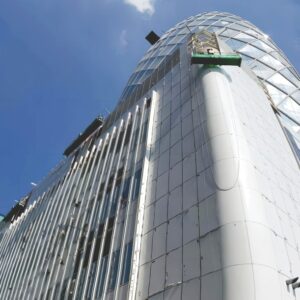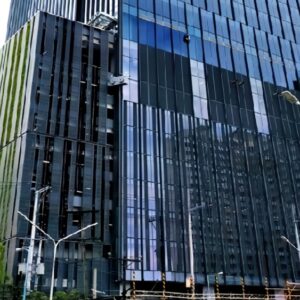Weldability
Introduction
EN AW 5754 H22 is a high-strength, magnesium-based aluminum alloy that combines excellent weldability with high mechanical properties and corrosion resistance. This article explores the weldability characteristics, effects of welding on its properties, and pre- and post-weld heat treatment requirements for EN AW 5754 H22.
Weldability Characteristics
- Excellent weldability: This alloy is easily welded using a variety of methods, including gas tungsten arc welding (GTAW), gas metal arc welding (GMAW), and resistance spot welding.
- Low sensitivity to hot cracking: The low melting point of magnesium in the alloy reduces the susceptibility to hot cracking during welding.
- High fatigue strength: Welded joints in EN AW 5754 H22 exhibit high fatigue strength, making it suitable for applications requiring high cyclic loads.
- Good corrosion resistance: The alloy retains its excellent corrosion resistance even after welding, thanks to the formation of a protective oxide layer on the weld surface.
Suitable Welding Methods
The most suitable welding methods for EN AW 5754 H22 are:
| Welding Method | Advantages |
|—|—|
| GTAW (TIG) | High-quality welds with minimum distortion, ideal for critical applications. |
| GMAW (MIG) | Fast and efficient, suitable for production welding. |
| Resistance Spot Welding | Cost-effective and high-speed method, used in automotive industry. |
Effects of Welding on Mechanical Properties
Welding can affect the mechanical properties of EN AW 5754 H22 due to:
- Localized heating: Welding introduces heat into the material, which can soften the base metal and the weld area.
- Grain growth: Grain growth can occur in the heat-affected zone, reducing the strength and toughness of the weldment.
To minimize these effects, proper welding parameters and techniques are essential.
Effects of Welding on Corrosion Resistance
While EN AW 5754 H22 maintains good corrosion resistance after welding, some factors can affect it:
- Weld porosity: Pores and other defects in the weld can provide entry points for corrosion.
- Incomplete penetration: Incomplete welds can expose the base metal to corrosion.
- Improper cleaning: Failure to remove welding flux or other contaminants can promote corrosion.
Carefully following welding procedures and post-weld cleaning is crucial for maintaining corrosion resistance.
Pre- and Post-Weld Heat Treatment
Pre- and post-weld heat treatment can enhance the mechanical properties and corrosion resistance of EN AW 5754 H22.
- Pre-weld heat treatment: Solutionizing at 475-495°C (887-923°F) can improve weldability and reduce residual stresses.
- Post-weld heat treatment: Aging at 120-130°C (248-266°F) for 10-12 hours can restore the alloy’s mechanical properties and enhance its corrosion resistance.
The specific heat treatment requirements depend on the welding method and the desired properties.
Conclusion
EN AW 5754 H22 is a weldable aluminum alloy with excellent mechanical properties and corrosion resistance. By choosing suitable welding methods, optimizing welding parameters, and employing proper heat treatment, it is possible to achieve high-quality welded joints in this alloy. Understanding the weldability characteristics and the effects of welding on its properties is essential for successful fabrication of components and structures using EN AW 5754 H22.
Corrosion Resistance
Introduction
EN AW-5754 H22 is a corrosion-resistant aluminum alloy commonly used in marine, automotive, and chemical processing applications. Its excellent resistance to corrosion makes it a reliable choice for demanding environments. This article explores the general corrosion resistance, stress corrosion cracking resistance, and surface treatments for enhancing corrosion protection of EN AW-5754 H22.
General Corrosion Resistance
EN AW-5754 H22 has exceptional general corrosion resistance in various environments, including:
- Atmospheric exposure
- Saltwater environments
- Mild acids and alkalis
- Industrial atmospheres
Its corrosion resistance is attributed to the formation of a protective oxide layer on the surface, which inhibits further corrosion.
Stress Corrosion Cracking and Pitting Resistance
In addition to general corrosion resistance, EN AW-5754 H22 exhibits good resistance to stress corrosion cracking and pitting. Stress corrosion cracking occurs when a material fails under the combined influence of stress and a corrosive environment. Pitting occurs when localized corrosion attacks the surface, forming small pits.
EN AW-5754 H22 has a high threshold for both stress corrosion cracking and pitting. This makes it suitable for applications where these factors are a concern, such as marine environments.
Surface Treatments and Coatings
While EN AW-5754 H22 has inherent corrosion resistance, surface treatments and coatings can further enhance its protective properties. Common surface treatments include:
- Anodizing: This electrochemical process creates a protective oxide layer that improves corrosion resistance and wear resistance.
- Chromate conversion coating: This chemical treatment forms a thin layer of chromates on the surface, enhancing corrosion protection.
- Paint and coatings: Applying protective paint or coatings can provide additional protection against harsh environments and mechanical damage.
The choice of surface treatment or coating depends on the specific application and desired level of corrosion resistance.
Comparison of Corrosion Resistance
To compare the corrosion resistance of EN AW-5754 H22 with other aluminum alloys, consider the following table:
| Alloy | General Corrosion Resistance | Stress Corrosion Cracking Resistance |
|—|—|—|
| EN AW-5754 H22 | Excellent | Good |
| EN AW-6061-T6 | Good | Moderate |
| EN AW-6082-T6 | Moderate | Poor |
As shown in the table, EN AW-5754 H22 outperforms EN AW-6061-T6 and EN AW-6082-T6 in terms of general and stress corrosion cracking resistance.
Applications
EN AW-5754 H22 is widely used in applications requiring excellent corrosion resistance, including:
- Marine structures
- Chemical tanks and pipelines
- Automotive components
- Aerospace components
- Food processing equipment
Its combination of strength, weldability, and corrosion resistance makes it a versatile choice for demanding environments.
Conclusion
EN AW-5754 H22 is a highly corrosion-resistant aluminum alloy that offers excellent protection in various environments. Its resistance to stress corrosion cracking and pitting, combined with the availability of surface treatments and coatings, makes it an ideal choice for applications where corrosion poses a significant challenge.
Applications
EN AW 5754 H22 is a versatile and durable aluminum alloy widely used in various industries due to its strength, corrosion resistance, and ease of fabrication.
Automotive Industry
In the automotive sector, EN AW 5754 H22 is utilized for a range of components, including trim, chassis parts, and body panels. Its lightweight and corrosion-resistant properties make it ideal for reducing vehicle weight and enhancing durability.
Marine Applications
Due to its excellent resistance to seawater corrosion, EN AW 5754 H22 is widely employed in marine applications. It is used for constructing boats, decks, and railings, providing long-lasting performance in demanding marine environments.
Building and Construction
In the building and construction industry, EN AW 5754 H22 is utilized for facade panels, window frames, and architectural details. Its exceptional strength and weatherability make it a reliable material for exterior applications.
Aerospace and Defense
EN AW 5754 H22 plays a crucial role in the aerospace and defense industries. It is used for aircraft components and armor plating due to its high specific strength, weight-saving potential, and ability to withstand extreme conditions.
Properties of EN AW 5754 H22
The exceptional properties of EN AW 5754 H22 include:
| Property | Value |
|—|—|
| Strength | High |
| Corrosion Resistance | Excellent |
| Weldability | Good |
| Formability | Good |
| Density | 2.68 g/cm³ |
| Tensile Strength | 290-345 MPa |
| Yield Strength | 220-280 MPa |
Advantages of EN AW 5754 H22
- Lightweight: Its low density makes it suitable for applications where weight reduction is essential.
- Durable: Excellent corrosion resistance ensures long-term performance in harsh environments.
- Versatile: Can be formed, welded, and machined with relative ease, offering design flexibility.
- Cost-Effective: Compared to other aluminum alloys, EN AW 5754 H22 offers a competitive price point.
Applications Comparison Table
| Industry | Component | Properties Required |
|—|—|—|
| Automotive | Trim, chassis | Strength, weight reduction, corrosion resistance |
| Marine | Boats, decks, railings | Corrosion resistance, durability |
| Building and Construction | Facade panels, window frames | Strength, weatherability, aesthetics |
| Aerospace and Defense | Aircraft components, armor plating | High strength-to-weight ratio, durability |
Conclusion
EN AW 5754 H22 is a versatile and reliable aluminum alloy utilized across a wide range of industries. Its combination of strength, corrosion resistance, and ease of fabrication makes it an ideal material for applications demanding durability, weight reduction, and cost-effectiveness.
Advantages
EN AW 5754 H22 is a high-performance aluminum alloy that offers a remarkable combination of properties, making it an ideal choice for a wide range of demanding applications. Here are its key advantages:
1. High Strength-to-Weight Ratio
EN AW 5754 H22 exhibits exceptional strength, comparable to steel, yet it is significantly lighter. This characteristic makes it ideal for applications where weight reduction and efficient mechanical performance are crucial.
2. Excellent Corrosion Resistance
The alloy possesses excellent corrosion resistance due to its high magnesium and manganese content, which forms a protective oxide layer on its surface. This property makes it suitable for use in marine environments, chemical processing, and other corrosive applications.
3. Good Machinability and Weldability
EN AW 5754 H22 exhibits good machinability, allowing for easy fabrication and shaping. It also has excellent weldability, enabling strong and reliable joints.
4. Lightweight and Conductive
As an aluminum alloy, EN AW 5754 H22 is lightweight and conductive. This makes it ideal for applications requiring electrical conductivity, such as wiring, electrical enclosures, and heat sinks.
Applications of EN AW 5754 H22
Due to its exceptional properties, EN AW 5754 H22 is used in various industries, including:
- Aerospace: Aircraft structures, skin panels, and components
- Automotive: Automotive frames, suspension systems, and brake calipers
- Marine: Boat hulls, decks, and superstructures
- Electronics: Electrical enclosures, heat sinks, and connectors
- Industrial Machinery: Structural components, conveyor systems, and machine tools
- Construction: Roofing, siding, and architectural trims
Comparison with Other Aluminum Alloys
The following table compares the properties of EN AW 5754 H22 with other common aluminum alloys:
| Property | EN AW 5754 H22 | EN AW 6061 T6 | EN AW 7075 T6 |
|—|—|—|—|
| Ultimate Tensile Strength | 320 MPa | 310 MPa | 570 MPa |
| Yield Strength | 275 MPa | 276 MPa | 500 MPa |
| Elongation at Break | 12% | 12% | 10% |
| Corrosion Resistance | Excellent | Good | Fair |
| Machinability | Good | Very good | Fair |
| Weldability | Excellent | Excellent | Good |
| Weight | Lightweight | Lightweight | Lightweight |
Conclusion
EN AW 5754 H22 aluminum alloy offers a unique combination of high strength-to-weight ratio, excellent corrosion resistance, good machinability, weldability, and conductivity. These properties make it an ideal choice for demanding applications across various industries, including aerospace, automotive, marine, electronics, and construction.
Disadvantages
Introduction
Aluminum alloy EN AW-5754 H22 is widely used in various applications due to its combination of lightweight, corrosion resistance, and machinability. However, like any material, it has certain disadvantages that should be considered before choosing it for a particular application. This article explores the key disadvantages of aluminum alloy EN AW-5754 H22.
1. Susceptibility to Hydrogen Embrittlement
Hydrogen embrittlement is a phenomenon where the presence of hydrogen within a metal can lead to decreased strength and ductility. Aluminum alloy EN AW-5754 H22 is susceptible to hydrogen embrittlement, especially when exposed to acidic environments or certain chemicals. This can occur during processes such as welding, electroplating, or exposure to sour gas conditions.
2. Lower Strength Compared to Other Aluminum Alloys
Compared to other commonly used aluminum alloys like 6061-T6, EN AW-5754 H22 has a lower ultimate tensile strength and yield strength. This means that it may not be suitable for applications requiring high strength-to-weight ratios, such as structural components or aerospace applications.
3. Sensitivity to Chemicals and Environments
Aluminum alloy EN AW-5754 H22 is sensitive to certain chemicals and environments. Exposure to alkalis, strong acids, and chloride-containing environments can cause corrosion and degradation. This can limit its use in marine applications, chemical processing equipment, or other environments where such chemicals are present.
Table: Comparison of Aluminum Alloys
| Property | EN AW-5754 H22 | 6061-T6 |
|—|—|—|
| Ultimate Tensile Strength | 290-310 MPa | 310-350 MPa |
| Yield Strength | 240-260 MPa | 276-310 MPa |
| Hydrogen Embrittlement Susceptibility | High | Low |
| Corrosion Resistance | Good | Excellent |
| Machinability | Good | Excellent |
Conclusion
While aluminum alloy EN AW-5754 H22 offers advantages such as lightweight, corrosion resistance, and machinability, it also has certain disadvantages that should be carefully considered before selecting it for an application. Its susceptibility to hydrogen embrittlement, lower strength compared to other alloys, and sensitivity to certain chemicals and environments limit its use in certain applications. By understanding these disadvantages, engineers and designers can make informed decisions and choose the most suitable aluminum alloy for their specific requirements.
Standards and Certifications
Introduction
EN AW 5754 H22 is an aluminum alloy widely used in various industries due to its high strength, corrosion resistance, and weldability. To ensure the quality and reliability of products using this alloy, adherence to industry standards and certifications is crucial.
Relevant Standards
The following standards are applicable to EN AW 5754 H22:
| Standard | Description |
|—|—|
| EN 573-3 | Aluminum and aluminum alloys – Chemical composition and form of wrought products |
| EN 515 | Aluminum and aluminum alloys – Wrought products – Temper designations |
| ASTM B209 | Standard Specification for Aluminum and Aluminum-Alloy Sheet and Plate |
| AA (Aluminum Association) Standard | Specifications for Aluminum Mill Products |
Certifications
In addition to meeting these standards, EN AW 5754 H22 may also be subject to certifications from various organizations. Some common certifications include:
| Certification | Description |
|—|—|
| ISO 9001 | Quality management system certification |
| AS9100 | Aerospace quality management system certification |
| PED (Pressure Equipment Directive) | Certification for pressure equipment in the European Union |
| CE (Conformité Européenne) | Mark of conformity for products sold in the European Economic Area |
Compliance with Regulations and Quality Requirements
Compliance with industry regulations and quality requirements is essential for products using EN AW 5754 H22. This ensures that the products are safe, reliable, and meet the specified performance criteria.
Key Compliance Points
To maintain compliance, the following key points must be addressed:
- Material Traceability: The origin and traceability of the alloy must be documented to ensure quality assurance.
- Mechanical Properties: The alloy must meet the specified mechanical properties, such as tensile strength, yield strength, and elongation.
- Chemical Composition: The alloy must adhere to the chemical composition requirements as defined in the relevant standards.
- Dimensional Accuracy: The product must conform to the specified dimensions and tolerances.
- Surface Quality: The surface of the product must be free from defects that may impair its performance.
Benefits of Adhering to Standards and Certifications
Adhering to standards and certifications for EN AW 5754 H22 provides numerous benefits, including:
- Product Reliability: Ensuring that products meet industry standards and quality requirements promotes confidence in their performance and durability.
- Customer Satisfaction: Compliance with standards demonstrates a commitment to customer satisfaction and provides reassurance about the product’s suitability.
- Reduced Liability: Adhering to regulations and certifications mitigates risks associated with product failures due to non-compliance.
- Market Access: Certification to industry standards can facilitate market access by meeting specific requirements for various industries, such as aerospace or automotive.
- Supply Chain Collaboration: Standards and certifications provide a common language for communication and collaboration within the supply chain, ensuring the consistent quality of products.
Conclusion
EN AW 5754 H22 is a high-performance aluminum alloy that finds applications in various industries. Adhering to relevant standards and certifications is essential to ensure the quality, reliability, and compliance of products using this alloy. Compliance with these requirements enhances product safety, customer satisfaction, and market access while reducing liability and fostering collaboration within the supply chain.
Alternatives
Introduction
Aluminum alloy EN AW-5754 H22 is a versatile alloy widely used in various industrial applications due to its combination of strength, corrosion resistance, and weldability. However, there are several alternative aluminum alloys that offer comparable properties and may be better suited for certain specific applications. This article explores the alternatives to EN AW-5754 H22, their comparative characteristics, and considerations for selecting the optimal material.
Alternative Aluminum Alloys
1. EN AW-6063 T6
- Similar strength and corrosion resistance to EN AW-5754 H22
- Higher ductility, making it more suitable for forming operations
- Less susceptible to stress corrosion cracking
- Widely used in architectural, transportation, and general engineering applications
2. EN AW-6082 T6
- Slightly higher strength than EN AW-5754 H22
- Excellent weldability and corrosion resistance
- Exceptional dimensional stability and machinability
- Suitable for high-strength structural applications, such as bridges and aerospace components
3. EN AW-5086 O
- Lower strength than EN AW-5754 H22
- Exceptionally high corrosion resistance
- Excellent machinability and weldability
- Used in marine and automotive applications, where corrosion resistance is paramount
4. EN AW-5052 H32
- Comparable strength to EN AW-5754 H22
- Superior corrosion resistance in marine environments
- High weldability and formability
- Suitable for boat hulls, roofing, and decorative applications
Comparison of Properties
| Property | EN AW-5754 H22 | EN AW-6063 T6 | EN AW-6082 T6 | EN AW-5086 O | EN AW-5052 H32 |
|—|—|—|—|—|—|
| Tensile strength (MPa) | 325 | 310 | 345 | 250 | 290 |
| Yield strength (MPa) | 275 | 220 | 310 | 180 | 220 |
| Elongation (%) | 13 | 18 | 12 | 23 | 17 |
| Corrosion resistance | Good | Excellent | Excellent | Outstanding | Excellent |
| Weldability | Good | Excellent | Very good | Good | Good |
Considerations for Material Selection
The choice of an alternative aluminum alloy depends on the specific application requirements. Factors to consider include:
- Strength: Structural applications require high-strength alloys, such as EN AW-6082 T6.
- Corrosion resistance: Marine and chemical environments demand alloys with exceptional corrosion resistance, such as EN AW-5086 O.
- Weldability: Applications involving welding require alloys with good to excellent weldability, such as EN AW-6063 T6 or EN AW-6082 T6.
- Formability: Parts requiring complex forming operations benefit from alloys with high ductility, such as EN AW-6063 T6.
- Cost: Different aluminum alloys have varying costs, which should be considered within the budget constraints.
Conclusion
While EN AW-5754 H22 is a versatile aluminum alloy, there are several alternative options that may be better suited for specific applications. By understanding the properties and characteristics of these alternatives and considering the relevant factors, engineers and designers can make informed material selection decisions that optimize performance and cost-effectiveness.
Cost Considerations
EN AW 5754 H22 is a high-strength, corrosion-resistant aluminum alloy widely used in various industrial applications. Understanding the cost factors associated with this alloy is crucial for project budgeting and material selection.
Material Cost and Availability
The cost of EN AW 5754 H22 aluminum alloy primarily depends on its form, size, and availability. Raw material supply and demand: The fluctuations in supply and demand for the alloy can significantly impact its cost. During periods of high demand or supply chain disruptions, the price of the alloy tends to rise. Forms and Sizes: The material cost can also vary based on the form of the aluminum, such as sheets, plates, coils, or extrusions. Larger quantities and standard sizes typically offer lower unit costs.
Production and Fabrication Costs
In addition to the material cost, several production and fabrication costs need to be considered:
| Cost Factor | Key Considerations |
|—|—|
| Cutting | CNC machining, sawing, and shearing operations can be expensive. The complexity of the cuts and the equipment used affect the cost. |
| Forming | Processes like bending, stamping, and extruding may require specialized equipment and tooling, increasing the production cost. |
| Welding | Welding of EN AW 5754 H22 requires specialized welding techniques and consumables to ensure the integrity of the joint. |
| Finishing | Surface treatments such as anodizing, painting, or powder coating can further add to the cost, depending on the desired finish and durability requirements. |
Material Comparison
To better understand the cost considerations, it’s helpful to compare EN AW 5754 H22 to other aluminum alloys commonly used in similar applications.
| Parameter | EN AW 5754 H22 | 6061-T6 | 7075-T6 |
|—|—|—|—|
| Strength | High | Moderate | High |
| Corrosion Resistance | Excellent | Good | Good |
| Weldability | Moderate | Good | Excellent |
| Availability | Readily available | Widely available | Less available |
| Cost | Moderate | Moderate | High |
Conclusion
The cost of EN AW 5754 H22 aluminum alloy is influenced by several factors, including material cost, production and fabrication processes, and market conditions. By understanding these factors and comparing them to other available options, engineers and project managers can make informed decisions when selecting materials for their applications.
Future Trends and Developments
Introduction
EN AW 5754 H22 is a specialized aluminum alloy known for its exceptional strength and corrosion resistance. With its versatility and wide range of applications, ongoing research and development is shaping the future of this material.
Ongoing Research and Development
- Improved Welding Techniques: Advancements in welding technologies are enabling manufacturers to produce stronger and more efficient joints.
- Enhanced Corrosion Protection: Research is focused on developing innovative surface treatments and coatings to further enhance the alloy’s resistance to corrosion.
- Weight Reduction: Research is ongoing to optimize the alloy’s composition and manufacturing processes to achieve greater weight reduction without compromising strength.
Emerging Technologies and Innovations
- Additive Manufacturing: 3D printing and other additive manufacturing techniques are revolutionizing the production of complex and lightweight components using EN AW 5754 H22.
- Digital Twin Technology: Digital twin simulations are used to predict the performance and durability of components made from EN AW 5754 H22 under various operating conditions.
- Advanced Coatings: Nano-engineered coatings are being developed to provide exceptional wear resistance, corrosion protection, and other enhanced properties.
Applications and Comparison
EN AW 5754 H22 is widely used in various industries, including:
- Automotive: Structural components, wheel rims, and suspension systems
- Aerospace: Aircraft skins, wings, and structural elements
- Marine: Boat hulls, masts, and deck fittings
Compared to other aluminum alloys, EN AW 5754 H22 exhibits:
| Property | EN AW 5754 H22 | EN AW 5083 H111 | EN AW 6061 T6 |
|—|—|—|—|
| Tensile Strength (MPa) | 325 | 310 | 310 |
| Yield Strength (MPa) | 290 | 275 | 275 |
| Corrosion Resistance | Excellent | Good | Good |
| Weldability | Excellent | Good | Good |
Future Prospects
The future of EN AW 5754 H22 looks promising with ongoing research and technological advancements. Its exceptional properties and versatility will continue to drive its adoption in demanding applications across various industries.
As these technologies mature, we can expect to see components manufactured with higher precision, improved functionality, and enhanced durability. This will not only benefit manufacturers but also end-users who demand high-quality and reliable products.
The potential applications for EN AW 5754 H22 are vast, and it is likely to play a significant role in shaping the future of various industries.





